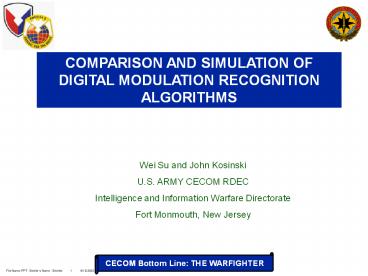Sample CECOM Standard Title Chart - PowerPoint PPT Presentation
Title:
Sample CECOM Standard Title Chart
Description:
File Name.PPT - Briefer's Name - Briefed. 1. Wei Su and John Kosinski. U.S. ARMY CECOM RDEC ... File Name.PPT - Briefer's Name - Briefed. 4 ... – PowerPoint PPT presentation
Number of Views:37
Avg rating:3.0/5.0
Title: Sample CECOM Standard Title Chart
1
COMPARISON AND SIMULATION OF DIGITAL MODULATION
RECOGNITION ALGORITHMS
Wei Su and John Kosinski U.S. ARMY CECOM
RDEC Intelligence and Information Warfare
Directorate Fort Monmouth, New Jersey
2
Automated Signal Exploitation and Modulation
Recognition
signal
Demodulated signal
Cooperative Communication
modulation type
pulse shaping
symbol rate
center frequency
signal
Non-cooperative Communication
?
?
?
?
Modulation recognition
Signal processing Statistical estimation
3
Factors Affect the Modulation Recognition Results
- Residual carrier frequency estimation
- Carrier frequency and phase tracking
- Baud rate estimation and pulse timing
- Pulse shaping recovery
- Channel distortion
4
Center frequency offset
PSK8 signal with phase shift produced by center
frequency offset
A PSK8 signal
5
Pulse Timing
- Re-sampling will be necessary if the symbol
frequency divided by sample frequency is not an
integer - Error is introduced in re-sampling
4 samples per symbol
10/3 samples per symbol
Before re-sampling
After re-sampling
6
Channel Distortion
Before 16-QAM After
An adaptive filter (lower figure) is used to
eliminate the multiple channel distortion in
wireless communication. A distorted 16-QAM signal
(left figure) is blindly equalized to give a
correct output (right figure) before recognition
process
7
Literature Search
- A web site search of modulation recognition
gave 52,500 hits. - More than a hundred publications on modulation
recognition. - Many GOTS and COTS products available for various
applications.
8
Some Well-known Approaches
- Modulation feature extraction
- I-Q Analysis
- Zero-crossing
- Power-law
- Modulation classification
- Pattern recognition
- Maximum likelihood
9
Problems in Algorithm Comparison
- Deferent modulation type
- Deferent assumption
- Deferent signal environment
- Deferent specification
MSK
FSK8
CW
FSK4
16QAM
FSK
FSK2
32QAM
PSK
64QAM
PSK8
PSK4
UNKNOWN
PSK
PSK2
ASK8
ASK4
ASK2
10
Azzouz and Nandis Method
- Based on signal parameter variances and variance
thresholds
11
Phase Variance is affected by the Center
Frequency Offset
phase tracking
unwrapped phase tracking
BPSK with residual carrier
after phase tracking and compensation
12
Phase Variance is Affected by Pulse Shaping (p/4
DQPSK)
13
Phase Variance is Affected by Phase Wrap
14
Limitation in Azzouz and Nandi
- Not robust to center frequency offset
- Not robust to pulse shaping
- Not robust to phase wrap
- Thresholds depend on SNR level
- Restricted in modulation types (2 bits)
15
Liedtkes Method
Based on delta-phase and histogram correlation
16
Limitation in Liedtkes Method
- Manual tuning of center frequency
- Manual tuning of the time-recovery band pass
filter - Limited in modulation types
17
Zero-crossing Detection Method
Based on zero-crossing phase, and delta phase
histogram
18
Limitation in Zero-Crossing Method
- Not robust to multiple frequencies
- Need high SNR
- Need high sampling rate
19
Power-Law Classification Method
Based on power spectrum analysis
20
Limitation to Power-Law Method
- Need very high sampling rate
- Affected by pulse shape
- Limited in modulation types
- Noise is amplified with high order
21
Modified Azzouz and Nandi
22
Center Frequency Offset Correction
Method 1
Estimated phase
symbol x
The unwanted phase rotation (left figure) is
corrected adaptively (right figure) by a modified
blind carrier phase tracker (upper figure) so
that the feature variation methods can be used
robustly for modulation recognition
Before BPSK After
Method 2 CFO angle( S(ykyk-1)fs/2/p k 1,
2, , N yk is a sample at k fs is the sampling
frequency
23
Modified Liedtke
IF
24
Summary
- There are many publications but most of them are
related to base band symbol recognition - Center frequency offset (CFO), pulse shape,
timing, and channel fading can be estimated but
the estimates will not be perfect - Signal type UNKNOWN should be defined in all
algorithms - A good modulation recognition algorithm should be
robust to CFO, timing error, and fading































